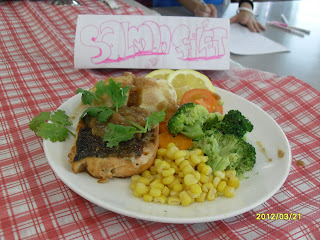2. The presentation of dish: The preentation was nice, colourful and bright.
 3. Identify and describe areas that are well done: We helped each other when there was difficulties
3. Identify and describe areas that are well done: We helped each other when there was difficulties4. Identify and describe the areas that need to be improved: The timing when baking the potato was wrong.
5. Describe how dish is suitable for the chosen person: The salmon contains Omega 3 fatty acids which is good for the body. Mr Jacob is suffering from diabetes and Mrs Jacob is suffering from hypertension, so the fish can reduce hypertension and diabetes and it can prevent cancer. Salmon can also prevent and helps build immune systems which is helpful to children.














